Stroke Rehabilitation Home Exercise Planner
Create a personalized home exercise plan based on your loved one's rehabilitation phase and therapy type. Follow evidence-based guidelines to maximize progress while avoiding common pitfalls.
Important Notes
Always consult with the rehabilitation team before starting any new exercise program. Stop immediately if the survivor shows signs of overexertion.
Personalized Exercise Plan
Safety Tips
When a loved one suffers a stroke and begins the long road of stroke rehabilitation, the person who steps in day after day is the caregiver a family member, friend, or professional who assists with daily tasks, therapy exercises, and emotional support. Understanding what that role really looks like can mean the difference between a slow, frustrating recovery and a steady, confidence‑building journey.
Key Takeaways
- Caregivers influence recovery at every stage-from hospital discharge to long‑term community living.
- Physical, occupational, and speech therapies each need specific caregiver actions.
- Creating a simple home‑exercise program and tracking progress keeps neuroplastic changes on track.
- Emotional encouragement and structured daily routines reduce post‑stroke depression.
- Avoiding common pitfalls-like over‑assistance or ignoring fatigue-keeps progress moving forward.
What Is Stroke Rehabilitation?
Stroke rehabilitation a coordinated set of therapies aimed at restoring function after a brain injury caused by disrupted blood flow typically involves three overlapping phases: acute hospital care, sub‑acute rehab (often in a specialized centre), and community‑based recovery at home. Each phase has its own goals, but the common thread is re‑training the brain through repetition, strength building, and relearning daily skills.
Phases of Recovery and Caregiver Involvement
During the acute phase, the medical team stabilises the patient and begins basic mobility work. Caregivers usually attend education sessions, learn safety tips, and help with simple positioning tasks.
In the sub‑acute phase, intensive therapy begins. Caregivers start to practice techniques learned from therapists-like assisted transfers or guided walking-right alongside the patient.
When the survivor returns home, the community phase kicks in. This is where the caregiver’s routine, encouragement, and problem‑solving shape long‑term outcomes.
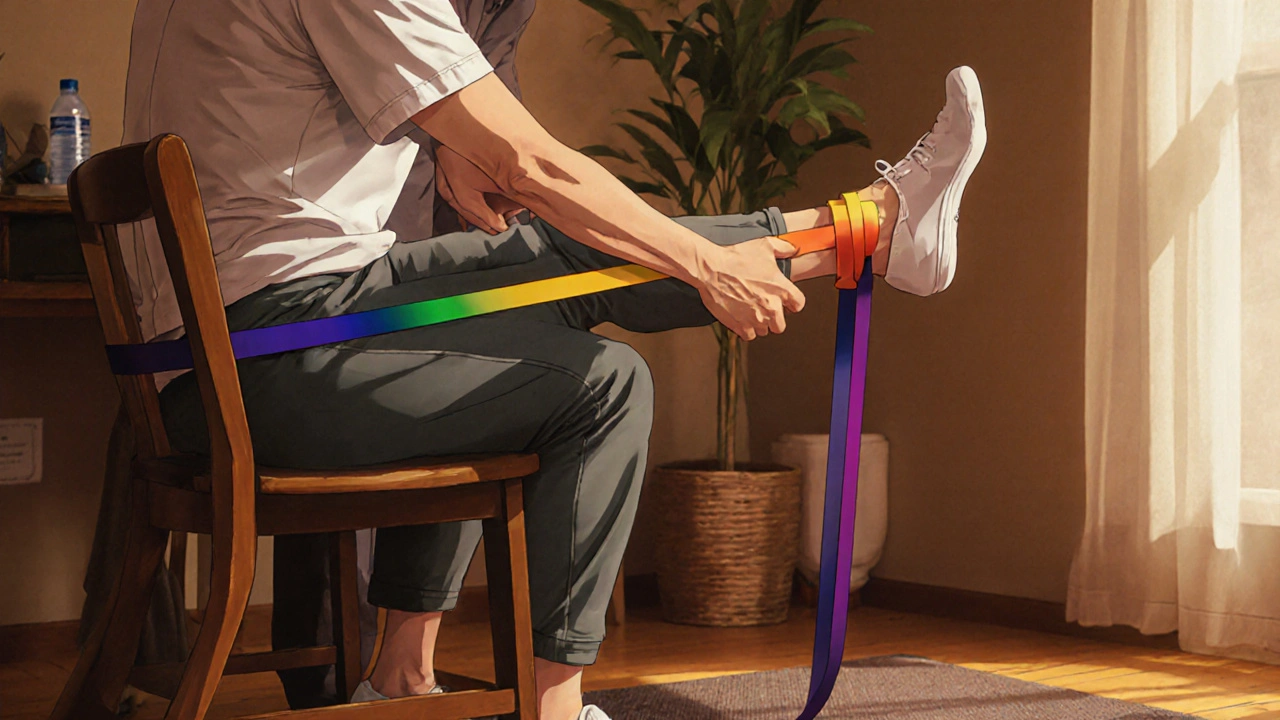
Core Therapies and How Caregivers Can Help
Three main therapy types dominate post‑stroke care. Below each, you’ll see concrete actions a caregiver can take.
Physical Therapy
Physical therapy focuses on strength, balance, and walking ability often starts with simple leg lifts or marching in place. Caregivers can:
- Assist with gait training by holding the survivor’s arm for safety, but let them bear as much weight as possible.
- Use household items (like a sturdy chair) for sit‑to‑stand practice.
- Monitor for signs of fatigue-stop after 10‑15 minutes of effort and resume later.
Occupational Therapy
Occupational therapy targets fine motor skills and the ability to perform Activities of Daily Living (ADLs). Caregivers can:
- Set up a tray with objects of varying sizes to practice grasp and release.
- Teach adaptive techniques, like using a dressing stick for putting on a shirt.
- Encourage independence by timing tasks-if a survivor can complete a step in under a minute, give positive feedback.
Speech Therapy
Speech therapy addresses language, swallowing, and cognitive‑communication deficits. Caregivers can:
- Practice word‑finding games during meals, turning therapy into a casual conversation.
- Follow the therapist’s swallowing safety plan-modify food textures as needed.
- Use simple, clear sentences and give the survivor time to respond.
Building a Home Exercise Program
After discharge, most survivors rely on a home exercise program a set of daily activities designed to reinforce gains made in therapy. A practical routine looks like this:
- Warm‑up: 5 minutes of gentle arm circles and ankle pumps.
- Strength: 2 sets of 10 seated march‑ins, holding onto a chair for support.
- Balance: 3 repetitions of standing on one foot for 10 seconds each, using a countertop for safety.
- Fine motor: 5 minutes of picking up coins or using a stress ball.
- Cool‑down: Deep breathing and light stretching of the neck and shoulders.
Log each session in a simple notebook-date, activity, duration, and any observations. Tracking creates a visual record of progress and helps therapists adjust the plan.
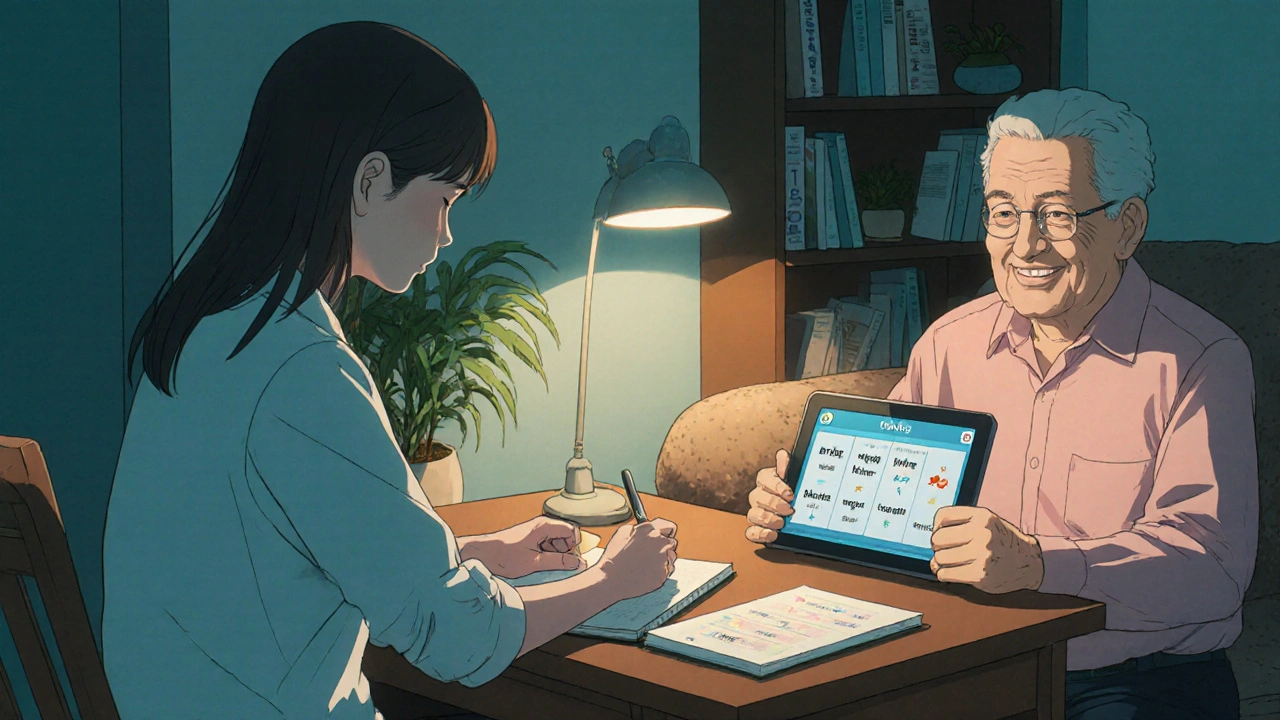
Emotional and Cognitive Support
Recovery isn’t just physical. Between 30 % and 50 % of stroke survivors experience depression or anxiety. Caregivers can:
- Schedule regular “talk time” where the survivor shares feelings without judgment.
- Introduce brain‑training apps that focus on memory and attention, keeping the sessions short (5‑10 minutes).
- Connect with local support groups organized meetings where survivors and families share experiences-many run virtually and fit easily into a weekly routine.
Common Pitfalls and Pro Tips
Even well‑meaning caregivers can unintentionally stall progress. Keep an eye out for these traps:
| Pitfall | Impact | Pro Tip |
|---|---|---|
| Doing too much for the survivor | Reduces muscle use, slows neuroplastic change | Encourage “do‑it‑yourself” attempts; assist only for safety. |
| Ignoring fatigue signals | Increases risk of falls and discouragement | Implement the “10‑minute rule” - rest after each 10‑minute effort. |
| Skipping therapy homework | Gaps in skill reinforcement | Set a daily alarm labeled “Therapy Time” and keep a checklist. |
| Neglecting emotional needs | Higher depression rates, poorer compliance | Schedule weekly social activities, even simple coffee chats. |
Remember, progress is often non‑linear. Celebrate small wins-like lifting a coffee cup without shaking-as they signal neuroplastic adaptation.
Resources and Next Steps
To keep moving forward, consider these actions:
- Arrange a follow‑up visit with the multidisciplinary team to review the home exercise log.
- Join an online community such as the Australian Stroke Foundation’s caregiver forum for peer advice.
- Download a reputable app (e.g., “Stroke Rehab Coach”) that aligns with therapist‑prescribed exercises.
- Schedule a “caregiver self‑care” day each month-rest, hobbies, or a short walk.
Being a caregiver is a demanding yet rewarding role. By staying informed, organized, and compassionate, you become a catalyst for real, lasting change in your loved one’s life.
How soon after a stroke should a caregiver start home exercises?
Most therapists recommend beginning low‑intensity exercises within 48‑72 hours of hospital discharge, provided the survivor’s medical team has cleared them for activity.
What equipment is essential for a home rehab setup?
A sturdy chair, resistance bands, a non‑slip mat, and a set of lightweight dumbbells (1‑2 kg) cover most basic exercises. Anything else can be improvised with household items.
How can I tell if my loved one is over‑exerting?
Watch for rapid breathing, sweating, facial flushing, or sudden weakness. If any appear, pause the activity and rest for at least five minutes.
Are there specific foods that support brain recovery?
A diet rich in omega‑3 fatty acids (fish, flaxseed), antioxidants (berries, leafy greens), and lean protein helps reduce inflammation and supports neuroplastic growth.
When should I involve a professional therapist again?
If progress stalls for more than two weeks, new gait or speech issues arise, or you’re unsure about safe techniques, schedule a reassessment with the rehab team.

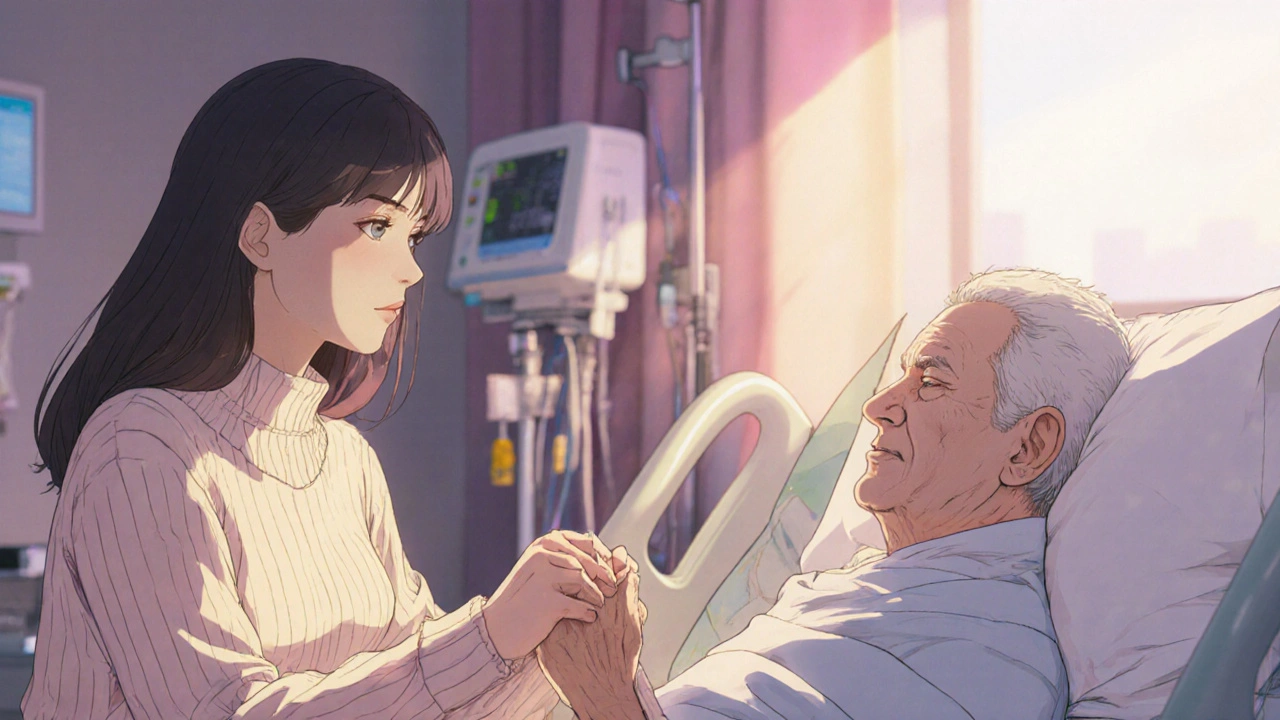
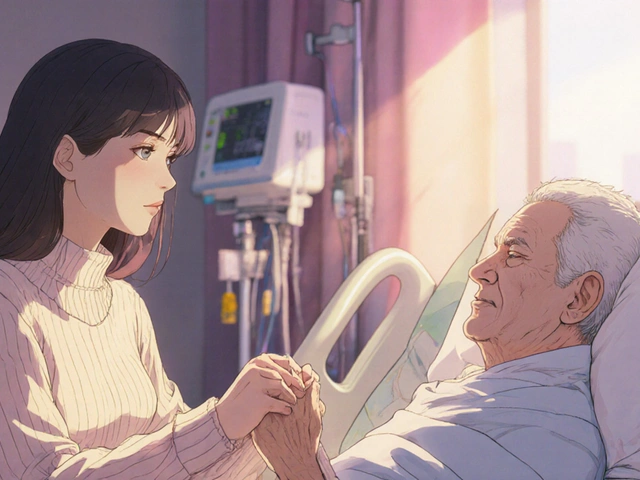
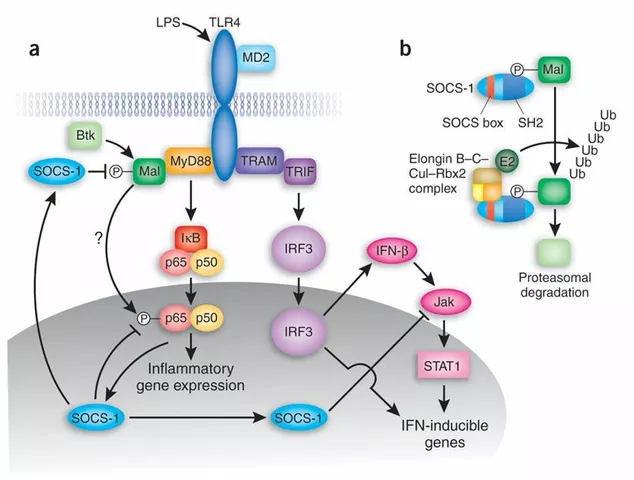
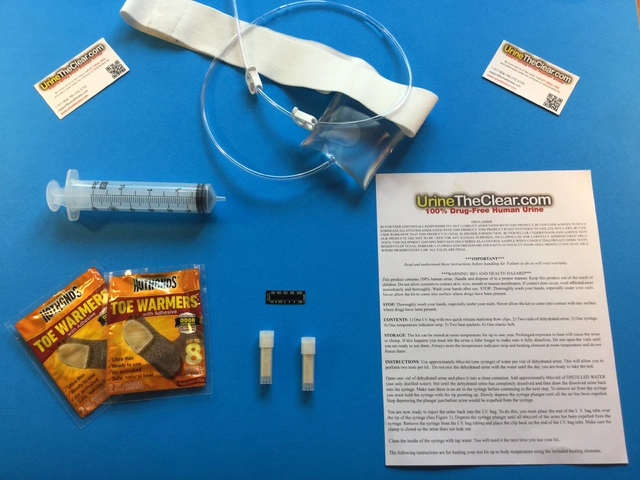

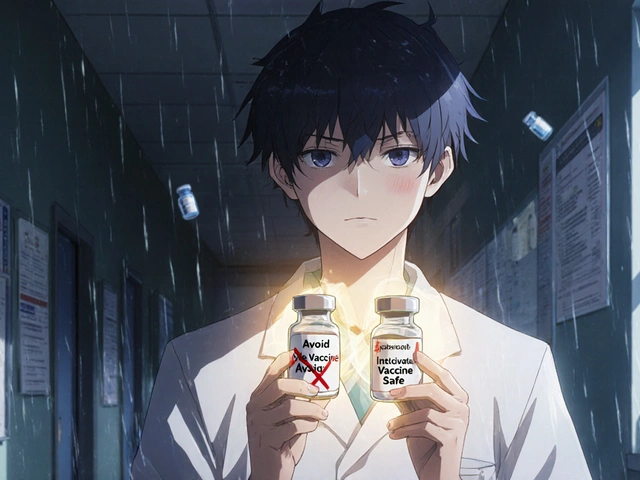

Comments
Yo i cant belive how many people ignore the simple sit‑to‑stand tip.
The role of the caregiver stretches beyond physical assistance. It is a daily practice of observation and gentle prompting. Consistency in therapy exercises often defines the trajectory of recovery. Emotional support, while intangible, weighs as heavily as any strength training. Balance between involvement and autonomy is the subtle art of caregiving.
Keep the exercises short and sweet.
A 10‑minute walk break prevents fatigue.
Celebrate the tiny wins each day.
Start with a quick warm‑up like arm circles before any strength work.
Use a sturdy chair for sit‑to‑stand drills and always watch for over‑exertion.
Setting a timer for 10‑minute intervals helps respect the fatigue rule you read about :)
Keep a simple log in a notebook to track progress and adjust with the therapist.
It is imperative to recognise that caregiver involvement must be calibrated precisely.
Over‑assistance directly impedes neuroplastic adaptation, a fact substantiated by peer‑reviewed literature.
Moreover, adherence to the prescribed ten‑minute rule mitigates the risk of post‑exercise fatigue.
Consequently, caregivers should adopt a structured, evidence‑based protocol rather than relying on anecdotal methods.
Don't you think it's just selfish to do everything for them they need to fight their own battles.
While enthusiasm is admirable, indiscriminate assistance often stalls progress.
Caregivers should evaluate each task for necessity before stepping in.
Unnecessary handling can erode confidence and muscle activation.
A measured approach aligns better with therapeutic goals.
Hey team, remember that every small step is a victory! Keep the routines light and fun, maybe add a favorite song during balance drills. Your positivity fuels their motivation and makes the rehab journey feel less grim. Celebrate each milestone, no matter how tiny.
One might argue that caregiving is an existential performance art where the caregiver becomes both conductor and audience of the body's rebirth process. Yet the practical reality remains grounded in simple repetition and patience.
Empirical data suggests that the efficacy of caregiver‑mediated home exercise regimens is contingent upon adherence metrics exceeding 85 %. Any deviation below this threshold compromises the neuroplastic consolidation window, contrary to popular belief that occasional lapses are benign.
The silence of neglect echoes louder than any shouted encouragement and it drags the soul into a void of despair.
Caregivers must confront this darkness with unwavering resolve.
Indeed, the sit‑to‑stand exercise constitutes a foundational component of functional recovery and warrants consistent practice.
Incorporating it into daily routines can significantly enhance lower‑body strength and confidence.
It is advisable to monitor the patient's form and adjust support as needed to promote autonomous movement.
Totally feel you Leo! Adding music turned our kitchen balance drills into a mini dance party and the mood lifted instantly. Keep the vibes alive and the progress will follow.
From a neurorehabilitation standpoint, integrating psychosocial support with motor training yields synergistic benefits, as delineated in recent systematic reviews. Caregivers should therefore adopt a biopsychosocial framework, aligning therapeutic exercises with emotional wellbeing to maximize functional outcomes.
There is a hidden agenda behind the glossy brochures that praise home exercise programs.
Pharmaceutical companies fund many of the so‑called ‘research studies’ that push caregivers toward certain equipment.
The recommendation of resistance bands, for instance, coincides with a surge in sales for a particular brand that quietly sponsors rehab clinics.
One must wonder why the same brands are never mentioned in the independent peer‑reviewed literature.
It is no coincidence that the timing of device advertisements aligns with the discharge dates of stroke patients.
The narrative of empowerment masks a profit‑driven motive that benefits corporations more than patients.
Even the apps touted as free often collect user data that can be sold to third parties.
The data feeds into larger health‑tech algorithms that influence insurance premiums.
Thus the caregiver unwittingly becomes a conduit for a data‑harvesting pipeline.
The supposed simplicity of a notebook log is a convenient distraction from the complex digital tracking happening behind the scenes.
Regulators remain silent, perhaps due to lobbying pressures from the very same industry.
This silence perpetuates a cycle where caregivers are left with little choice but to follow the prescribed commercial pathway.
Critical thinking is essential, yet the information asymmetry makes it difficult for the average family member.
Alternative community‑driven programs exist, but they rarely receive the same level of funding or publicity.
In the end, the true cost of ‘free’ guidance may be the erosion of privacy and autonomy.
Caregivers should remain vigilant, question the source of every recommendation, and prioritize evidence that is transparent and unbiased.